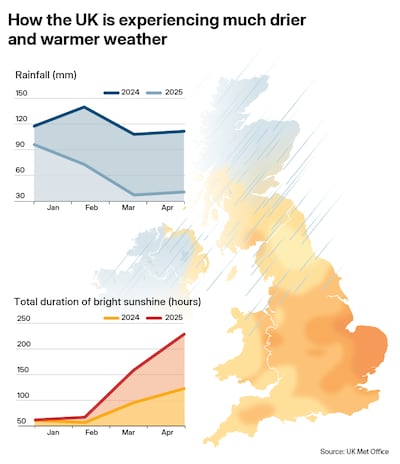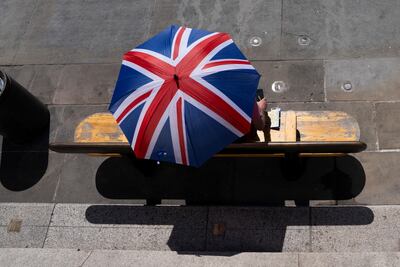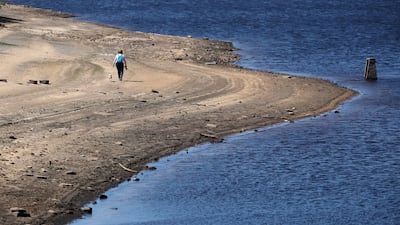Climate records continue to tumble across the world as global warming upends established weather patterns – and spring 2025 in the UK fits squarely into this.
The nation’s Met Office has reported that April this year was the sunniest ever and the third-warmest on record, while spring is so far the driest for more than a century, with just 80.6mm of rainfall, compared to an average of 229mm.
While this week has brought some rain to areas, reservoir levels remain low and if there is no significant rain to come, there is a “medium” risk of drought, the Environment Agency, which covers England, has warned, while analysts have said that there could be an increased risk of wildfires and restrictions on water use.
However, while some climate analysts have highlighted the impact that climate change may be having, other factors, such as improvements in air pollution, which have been taking place over decades, have also been cited as contributing to the record sunshine.
Dr Phillip Williamson, an honorary associate professor and climate researcher at the University of East Anglia in the UK, said that it was “absolutely parched” at his home in the east of England.
“It’s going to be really serious unless there’s really significant rain,” he told The National. “If it doesn’t rain... trees will die and crops will fail. It will be catastrophic.”
Worrying signs
Farmers have already warned that crops such as sugar beet have not grown as much as normal by this time of year, and some have started irrigating fields early.
A severe drought in the UK that began in late 1975 and stretched into the following summer caused yields of crops such as spring barley to fall by up to 50 per cent in some regions, according to reports cited by the country’s Centre for Hydrology and Ecology, potentially indicating what may happen if the coming months are unusually dry.
A factor behind the balmy conditions is that high-pressure systems, typically from continental Europe or the Azores, have persisted since February, according to the Met Office.
This is largely because the jet stream, an air current high in the atmosphere, has been passing north of the UK more often than usual.
But with the tumbling of climatic records seemingly now the norm, is climate change also a factor?
“It’s very difficult to say for certain for any particular pattern whether it’s climate change, but climate change makes these extreme conditions much more likely,” Dr Williamson said.
“Instead of once in 100 years, it now seems like it’s a once in 10 years event. The extreme events seem to be coming with increasing frequency.”

According to figures published by the Met Office – calculated by comparing 1961 to 1990 with 1991 to 2020 – the UK’s average temperature has risen by 0.8°C. Over the same time there has been a 7.3 per cent increase in rainfall and a 5.6 per cent rise in the amount of sunshine.
Bob Ward, of the Grantham Research Institute on Climate Change and the Environment, part of the London School of Economics and Political Science, said that factors other than climate change are likely to have contributed to the recent weather.
He said improvements in air quality in Europe, driven by environmental legislation, may have contributed to the high levels of sunshine recorded.
Reduced pollution
Air pollution particles, by acting as condensation nuclei – particles around which water vapour condenses – encourage the formation of clouds, which can block out sunlight, so cut in pollution can cause sunnier conditions. The particles themselves block out some sunlight.
“It’s not yet clear there’s a pattern of increased dryness and hard therefore to say the current drought conditions … are linked to climate change,” Mr Ward added.
“That’s not to say there is no impact. It would be surprising if climate change isn’t having some impact if not on the frequency, certainly on the intensity, because climate change is affecting… weather patterns.”
Figures published by the UK’s Institute for Fiscal Studies indicate that levels of the smallest particulate matter air pollution, known as PM2.5s, have fallen 54 per cent since 2003, although 96 per cent of the population still lives in areas where pollution is above the maximum recommended by the World Health Organisation of 5 micrograms per cubic metre.
Dr Ramit Debnath, an assistant professor of mathematics and social design at the University of Cambridge who researches climate change, said that “definitely the climate change is a factor” in the recent weather.
“With more climate change impacts this is a compound effect… that can become more fierce in the future,” he said.
The heat is on
Unless there is a significant amount of rain soon, Dr Williamson warned that the recent dry spell may herald a particularly hot summer in the UK.
“Once we get to the dry weather in the summer proper, in June and July, we’re likely to get higher temperatures. If the ground is dry it heats up more. If it’s rained before the evaporation cools it down and cools the air down. Once you get dry conditions you get positive feedback,” he said.
On 19 July 2022 the UK recorded a record high temperature of 40.3°C in Coningsby in Lincolnshire in the east of the country – the first time the mercury had risen above 40°C in the country.

The same day the London Fire Brigade recorded its busiest day since the Second World War as the hot and dry conditions sparked dozens of fires.
Mr Ward said that this spring’s dry weather created “a severe risk” of similar conditions that increased the risk of wildfires, and there could be a need for tighter restrictions on water use because reservoirs are not being replenished.
The recent sunny and dry spell highlighted the importance of investing in renewable energy and “moving away from fossil fuels”, Dr Williamson said.
“If you don’t have net zero, you’re increasing the greenhouse gases in the atmosphere,” he said. “Once that goes beyond a certain point, we might have runaway feedbacks that just make it worse and even if we did reduce emissions to zero, you cannot bring it back.
“There are then very extreme measures that can be taken and we’re in a different world and it’s very problematic.”
For the immediate term, however, from this weekend weather over much of the UK is forecast to turn wetter, with low pressure and cloudier conditions forecast as the jet stream diverts further south than it has been doing recently, potentially offering respite to parched gardens and fields.
Farmers, gardeners and others will be watching to see if this just a temporary respite from the dry conditions.






